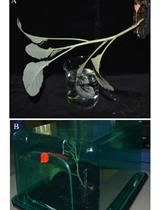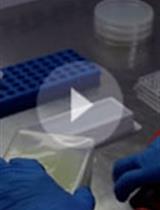- EN - English
- CN - 中文
Tracking Root Interactions System (TRIS) Experiment and Quality Control
根相互作用系统的示踪实验和质量控制
发布: 2019年04月20日第9卷第8期 DOI: 10.21769/BioProtoc.3211 浏览次数: 7259
评审: Yan BaoRaghuram BadmiAnonymous reviewer(s)
Abstract
Soil organisms are diverse taxonomically and functionally. This ecosystem experiences highly complex networks of interactions, but may also present functionally independent entities. Plant roots, a metabolically active hotspot in the soil, take an essential part in shaping the rhizosphere. Tracking the dynamics of root-microbe interactions at high spatial resolution is currently limited due to methodological intricacy. In this study, we developed a novel microfluidics-based device enabling direct imaging of root-bacteria interactions in real time.
Keywords: Tracking root interactions system (TRIS) (根相互作用系统示踪)Background
Plant roots play a major role in shaping plant-microbe interactions within the rhizosphere, driving a dynamically changing microenvironment. Recent studies revealed multiple beneficial effects of root-associated bacteria (Hardoim et al., 2008; Weyens et al., 2009; Mei and Flinn, 2010; Santhanam et al., 2015), highlighting the important role of rhizosphere interactions. Tracking these interactions with high spatio-temporal resolution is a challenging task that is primarily limited by available methodologies. Several microfluidic approaches have recently been adapted for the use in the plant sciences (reviewed by Sanati Nezhad, 2014 and Stanley et al., 2016) mainly for root development and physiological studies (Englert et al., 2010; Grossmann et al., 2011; Jiang et al., 2014). The TRIS device presented here builds on these developments to provide a robust platform for microscopy-based studies of the interactions between plant roots and associated microorganisms that can be implemented in a typical experimental biology laboratory (Massalha et al., 2017). The TRIS device enables precise control over environmental parameters within the system while allowing direct observation of dynamic biological processes at high spatial and temporal resolutions. Here we discuss in details the TRIS assembly and operation. Studying root-microbe interactions in this device allows the use of endless combinations of bacterial strains and plant genotypes that could be examined with multiple fluorescent reporters. Altogether, we hope and anticipate that the TRIS experimental system, and other platforms building upon it, will open the way for extensive high-resolution studies of the dynamic root microenvironment and interactions within it.
Materials and Reagents
- Petri dishes (150 mm x 25 mm) (Corning, catalog number: CLS430597)
- Petri dishes (100 mm) (Corning, catalog number: CLS430591)
- 200 µl plastic tips
- Sterile 14 ml polystyrene culture tubes (Corning, catalog number: 352057)
- Glass slides (75 mm x 25 mm) (Thermo, catalog number: 421-004T)
- Adhesive tape (Cellophane tape)
- Millex-HV Syringe Filter Unit, 0.45 µm, PVDF (Merck, Millipore, catalog number: SLHVM33RS)
- 1 ml syringes (BD, catalog number: 309647)
- Polyethylene tubing (OD 1.2 mm) (BD, IntramedicTM, Clay Adams®)
- Regular bamboo toothpicks (can be obtained from any supermarket)
- Parafilm
- 1.5 ml tubes (Eppendorf, catalog number: 0030120086)
- Blunt end needle (McKESSON, catalog number: 8881202363)
- Cotton (can be obtained from any supermarket)
- Biohazard bag (the institute warehouse)
- Arabidopsis seeds (Col-0)
- Bacillus subtilis
- Glycerol stock of Bacillus subtilis NCIB 3610 mCherry reporter strain (obtained from a single colony, stored at -80 °C)
- Polydimethylsiloxane (PDMS) and Curing agent (Sylgard 184 Silicone Elastomer Kit) (Dow Corning Corporation)
- 100% Ethanol (Sigma, catalog number: 34852)
- dH2O (Sigma, catalog number: W4502)
- KOH (Sigma, catalog number: P5958)
- HCl (Sigma, catalog number: H1758) and bleach (Sigma, catalog number: 425044) for seed sterilization.
- Half strength plant growth media, basal salt Murashige and Skoog (MS) (Duchefa Biochemie, catalog number: M0221)
- Plant agar (Duchefa Biochemie, CAS number: 9002-18-0)
- TB buffer (see Recipes)
Equipment
- Forceps
- Scalpel
- 250-ml glass flask
- Pipettes (Eppendorf 20, 200, 1,000 µl)
- Oven
- Hot plate
- OD (600 nm) reader
- 37 °C shaking incubator
- Microfluidic channel mold (see attached CAD file)
- SU-8 2150 (MicroChem Corp.)
- Desiccator with vacuum line
- Harris Unicore hole punch (1 mm) (Ted Pella, catalog number: 15074)
- Hand-held corona generator (Laboratory Corona Treater, Electro-Technic Products, model: BD-20AC)
- Autoclave
- Desiccator
- Inverted optical microscope equipped with dark-field objective (e.g., Olympus)
- Confocal microscope with automated stage system (e.g., Nikon Ti-eclipse)
Software
- Dedicated confocal microscope software
In this study, we used the Nikon confocal and the NIS-element program. - Fiji (ImageJ)
Procedure
文章信息
版权信息
© 2019 The Authors; exclusive licensee Bio-protocol LLC.
如何引用
Massalha, H., Korenblum, E., Shapiro, O. H. and Asaph, A. (2019). Tracking Root Interactions System (TRIS) Experiment and Quality Control. Bio-protocol 9(8): e3211. DOI: 10.21769/BioProtoc.3211.
分类
植物科学 > 植物生理学 > 生物胁迫
微生物学 > 微生物-宿主相互作用 > 体内实验模型 > 植物
您对这篇实验方法有问题吗?
在此处发布您的问题,我们将邀请本文作者来回答。同时,我们会将您的问题发布到Bio-protocol Exchange,以便寻求社区成员的帮助。
Share
Bluesky
X
Copy link













